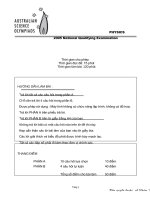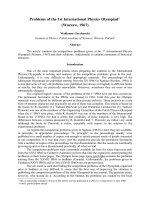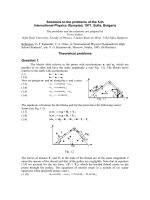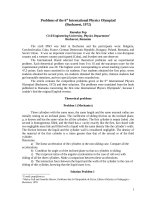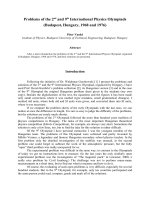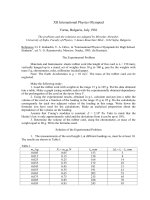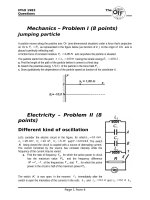De thi vat li quoc te IPHO nam 20045
Bạn đang xem bản rút gọn của tài liệu. Xem và tải ngay bản đầy đủ của tài liệu tại đây (194.46 KB, 6 trang )
<span class='text_page_counter'>(1)</span><div class='page_container' data-page=1>
<b>Theoretical Question 3: </b><i><b>Scanning Probe Microscope </b></i>
<b>1. Answers </b>
(a)
2
2
2
2
2
0
2
0
)
(ω ω <i>b</i> ω
<i>m</i>
<i>F</i>
<i>A</i>
+
−
= and
)
(
tan <sub>2</sub> <sub>2</sub>
0
0
ω
ω
ω
φ
−
=
<i>m</i>
<i>b</i>
. At ω =ω<sub>0</sub>,
0
0
ω
<i>b</i>
<i>F</i>
<i>A</i>=
and
2
π
φ = .
(b) A non-vanishing dc component exists only when ω =ω<i><sub>i</sub></i>.
In this case the amplitude of the dc signal will be <i>V<sub>i</sub></i> <i>V<sub>R</sub></i> cosφ<i><sub>i</sub></i>
2
1
0
0 .
(c)
0
2
0
2
1
2 <i>b</i>ω
<i>V</i>
<i>c</i>
<i>c</i> <i><sub>R</sub></i>
at the resonance frequency ω<sub>0</sub>.
(d) <sub>∆</sub><i><sub>m</sub></i><sub>=</sub><sub>1</sub><sub>.</sub><sub>7</sub><sub>×</sub><sub>10</sub>−18<sub> kg. </sub>
(e)
2
/
1
2
0
3
0
0 1
' <sub></sub>
−
=
ω
ω
ω
<i>m</i>
<i>c</i>
.
(f)
3
/
1
0
0
0
∆
=
ω
ω
<i>m</i>
<i>qQ</i>
<i>k</i>
<i>d</i> <i><sub>e</sub></i>
=
0
</div>
<span class='text_page_counter'>(2)</span><div class='page_container' data-page=2>
<b>2. Solutions </b>
(a) [1.5 points]
Substituting <i>z</i>(<i>t</i>)= <i>A</i>sin(ω<i>t</i>−φ) in the equation <i>m</i> <i>z</i> <i>F</i> <i>t</i>
<i>dt</i>
<i>dz</i>
<i>b</i>
<i>dt</i>
<i>z</i>
<i>d</i>
<i>m</i> ω2 <sub>0</sub>sinω
0
2
2
=
+
+
yields,
<i>t</i>
<i>A</i>
<i>F</i>
<i>t</i>
<i>m</i>
<i>t</i>
<i>b</i>
<i>t</i>
<i>m</i>ω sin(ω φ) ωcos(ω φ) ω 2sin(ω φ) 0sinω
0
2 <sub>−</sub> <sub>+</sub> <sub>−</sub> <sub>+</sub> <sub>−</sub> <sub>=</sub>
− . (a1)
Collecting terms proportional to sinω<i>t</i> and cosω<i>t</i>, one obtains
{
( )sin cos}
cos 0sin
sin
cos
)
( 2 2
0
0
2
2
0 + − − + =
<sub>−</sub> <sub>+</sub> <sub>−</sub> <i><sub>t</sub></i> <i><sub>m</sub></i> <i><sub>b</sub></i> <i><sub>t</sub></i>
<i>A</i>
<i>F</i>
<i>b</i>
<i>m</i> ω ω φ ω φ ω ω ω φ ω φ ω (a2)
Zeroing the each curly square bracket produces
)
(
tan <sub>2</sub> <sub>2</sub>
0 ω
ω
ω
φ
−
=
<i>m</i>
<i>b</i>
, (a3)
2
2
2
2
2
0
2
0
)
(ω ω <i>b</i> ω
<i>m</i>
<i>F</i>
<i>A</i>
+
−
= . (a4)
At ω =ω<sub>0</sub>,
0
0
ω
<i>b</i>
<i>F</i>
<i>A</i>= and .
2
π
φ = (a5)
(b) [1 point]
The multiplied signal is
}]
)
cos{(
}
)
[cos{(
2
1
)
sin(
)
sin(
0
0
0
0
<i>i</i>
<i>i</i>
<i>i</i>
<i>i</i>
<i>R</i>
<i>i</i>
<i>R</i>
<i>i</i>
<i>i</i>
<i>i</i>
<i>t</i>
<i>t</i>
<i>V</i>
<i>V</i>
<i>t</i>
<i>V</i>
<i>t</i>
<i>V</i>
φ
ω
ω
φ
ω
ω
ω
φ
ω
−
+
−
−
−
=
−
(b1)
A non-vanishing dc component exists only when ω=ω<i><sub>i</sub></i>. In this case the amplitude of
the dc signal will be
<i>i</i>
<i>R</i>
<i>i</i> <i>V</i>
<i>V</i> cosφ
2
1
0
0 . (b2)
(c) [1.5 points]
</div>
<span class='text_page_counter'>(3)</span><div class='page_container' data-page=3>
cantilever, and the frequency of the photodiode detector should be same. The
magnitude of the input signal at the resonance is
0
0
2
1
0
0
2
0 <sub>ω</sub> <i><sub>b</sub></i><sub>ω</sub>
<i>V</i>
<i>c</i>
<i>c</i>
<i>b</i>
<i>F</i>
<i>c</i>
<i>V</i> <i>R</i>
<i>i</i> = = . (c1)
Then, since the phase of the input signal is 0
2
2 + =
−π π at the resonance, φ<i><sub>i</sub></i> =0 and
the lock-in amplifier signal is
0
2
0
2
1
0
0
2
0
cos
2
1
ω
<i>b</i>
<i>V</i>
<i>c</i>
<i>c</i>
<i>V</i>
<i>V</i> <i>R</i>
<i>R</i>
<i>i</i> = . (c2)
(d) [2 points]
The original resonance frequency
<i>m</i>
<i>k</i>
=
0
ω is shifted to
<sub>−</sub> ∆
=
<sub>−</sub> ∆
≅
<sub>+</sub> ∆
=
∆
+
−
<i>m</i>
<i>m</i>
<i>m</i>
<i>m</i>
<i>m</i>
<i>k</i>
<i>m</i>
<i>m</i>
<i>m</i>
<i>k</i>
<i>m</i>
<i>m</i>
<i>k</i>
2
1
1
2
1
1
1 2 <sub>0</sub>
1
ω . (d1)
Thus
<i>m</i>
<i>m</i>
∆
−
=
∆ <sub>0</sub> <sub>0</sub>
2
1<sub>ω</sub>
ω . (d2)
Near the resonance, by substituting φ→π +∆φ
2 and ω0 →ω0 +∆ω0 in Eq. (a3), the
change of the phase due to the small change of ω<sub>0</sub> (not the change of ω) is
0
2
tan
1
2
tan
ω
φ
φ
π
∆
=
∆
−
=
<sub>+</sub><sub>∆</sub>
<i>m</i>
<i>b</i>
. (d3)
Therefore,
<i>b</i>
<i>m</i> <sub>0</sub>
2
tan φ ω
φ ≈ ∆ =− ∆
∆ . (d4)
From Eqs. (d2) and (d4),
18
18
6
12
3
0
10
7
.
1
10
8
.
1
1800
10
10
10 ⋅ − <sub>=</sub> − <sub>=</sub> <sub>×</sub> −
=
∆
=
∆ φ π π
ω
<i>b</i>
<i>m</i> kg. (d5)
(e) [1.5 points]
In the presence of interaction, the equation of motion near the new equilibrium position
0
</div>
<span class='text_page_counter'>(4)</span><div class='page_container' data-page=4>
<i>t</i>
<i>F</i>
<i>z</i>
<i>c</i>
<i>z</i>
<i>m</i>
<i>dt</i>
<i>dz</i>
<i>b</i>
<i>dt</i>
<i>z</i>
<i>d</i>
<i>m</i> ω2 <sub>3</sub> <sub>0</sub>sinω
0
2
2
=
−
+
+ (e1)
where we used <i>f</i>(<i>h</i>)≈ <i>f</i>(<i>h</i><sub>0</sub>)+<i>c</i><sub>3</sub><i>z</i> with <i>z</i>=<i>h</i>−<i>h</i><sub>0</sub> being the displacement from the
new equilibrium position <i>h</i><sub>0</sub>. Note that the constant term <i>f</i>(<i>h</i><sub>0</sub>) is cancelled at the
new equilibrium position.
Thus the original resonance frequency
<i>m</i>
<i>k</i>
=
0
ω will be shifted to
2
0
3
0
3
2
0
3
0 1
'
ω
ω
ω
ω
<i>m</i>
<i>c</i>
<i>m</i>
<i>c</i>
<i>m</i>
<i>m</i>
<i>c</i>
<i>k</i>− <sub>=</sub> − <sub>=</sub> <sub>−</sub>
= . (e3)
Hence the resonance frequency shift is given by
−
−
=
∆ 1 <sub>2</sub> 1
0
3
0
0 ω <sub>ω</sub>
ω
<i>m</i>
<i>c</i>
. (e4)
(f) [2.5 points]
The maximum shift occurs when the cantilever is on top of the charge, where the
interacting force is given by
2
)
(
<i>h</i>
<i>qQ</i>
<i>k</i>
<i>h</i>
<i>f</i> = <i><sub>e</sub></i> . (f1)
From this,
3
0
3 2
0 <i>d</i>
<i>qQ</i>
<i>k</i>
<i>dh</i>
<i>df</i>
<i>c</i> <i><sub>e</sub></i>
<i>d</i>
<i>h</i>
−
=
=
=
. (f2)
Since ∆ω<sub>0</sub> <<ω<sub>0</sub>, we can approximate Eq. (e4) as
0
3
0 <sub>2</sub> <sub>ω</sub>
ω
<i>m</i>
<i>c</i>
−
≈
∆ . (f3)
From Eqs. (f2) and (f3), we have
3
0
0
3
0
0
0 2
2
1
<i>d</i>
<i>m</i>
<i>qQ</i>
<i>k</i>
<i>d</i>
<i>qQ</i>
<i>k</i>
<i>m</i>ω <i>e</i> <i>e</i> ω
ω <sub></sub>=
−
−
=
∆ . (f4)
</div>
<span class='text_page_counter'>(5)</span><div class='page_container' data-page=5>
8
3
/
1
0
0
0 4.1 10
−
×
=
∆
=
ω
ω
<i>m</i>
<i>qQ</i>
<i>k</i>
<i>d</i> <i><sub>e</sub></i> m = 41 nm. (f5)
</div>
<span class='text_page_counter'>(6)</span><div class='page_container' data-page=6>
<b>3. Mark Distribution </b>
No. Total
Pt.
Partial
Pt. Contents
0.7 Equations for <i>A</i> and φ (substitution and manipulation)
0.4 Correct answers for<i>A</i> and φ
(a) 1.5
0.4 <i>A</i> and φ at ω<sub>0</sub>
0.4 Equation for the multiplied signal
0.3 Condition for the non-vanishing dc output
(b) 1.0
0.3 Correct answer for the dc output
0.6 Relation between <i>V<sub>i</sub></i> and <i>V<sub>R</sub></i>
0.4 Condition for the maximum dc output
(c) 1.5
0.5 Correct answer for the magnitude of dc output
0.5 Relation between ∆<i>m</i> and ∆ω<sub>0</sub>
1.0 Relations between ∆ω<sub>0</sub> (or ∆<i>m</i>) and ∆φ
(d) 2.0
0.5 Correct answer (Partial credit of 0.2 for the wrong sign.)
1.0 Modification of the equation with <i>f</i>(<i>h</i>) and use of a proper
approximation for the equation
(e) 1.5
0.5 Correct answer
0.5 Use of a correct formula of Coulomb force
0.3 Evaluation of <i>c</i><sub>3</sub>
0.6 Use of the result in (e) for either ∆ω<sub>0</sub> or ω'2<sub>0</sub>−ω<sub>0</sub>2
0.6 Expression for <i>d</i><sub>0</sub>
(f) 2.5
0.5 Correct answer
</div>
<!--links-->
